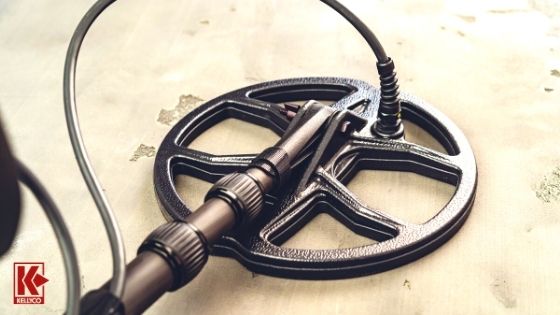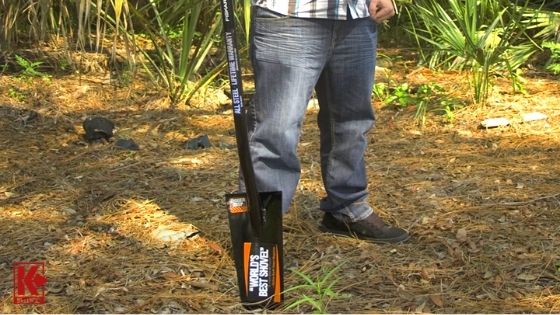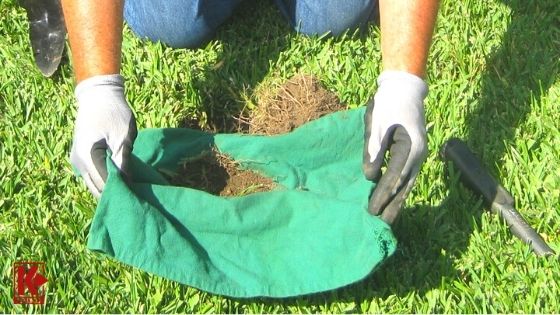The Complete Guide to Metal Detecting Accessories
Published by Jenna Anderson on 06/26/16
Best Sand Scoops For Metal Detecting
Picking out the right metal detector for the right treasure hunting experience is crucial to its success. What most people don’t know is that this piece of advice also translates to the type of sand scoop used for digging up treasure near sand and water. By picking out the best sand scoops for the job, targets can be recovered much faster and with greater ease.
The first thing to think of when choosing a sand scoop for metal detecting is where it will be used. Using any sand scoop for metal detecting inland and away from water will protect it from the corrosive properties of salt water. For metal detecting near larger bodies of water, it is imperative to get a metal sand scoop that can stand up to these abrasive elements. That’s why most metal detecting enthusiasts, who hunt near the sea, use a stainless steel beach scoop that can stand up to corrosion. However, there are newer plating methods being produced to stop metal detecting scoops from corroding. Nevertheless, it’s better to use a stainless steel metal scoop when treasure hunting near any body of water because its never full proof.
There is also the size of the sand scoop to consider. Metal detecting scoops come in three distinct sizes: short handle scoops, medium handle scoops and long handle scoops. Short handle scoops are perfect for sandboxes, the beach or anywhere with loose soil. The upside to using a short handle for metal detecting is that they’re great for getting exercise. Medium handle scoops are great for sandy beaches where the depth of targets are not always exact. Long handle sand scoops are made for digging into water on the beach or near the shoreline a breeze. These large handle scoops are great for any depth of water because most rings and jewelry are found at waist deep.
Lastly, the type of sand scoop can affect the metal detecting experience based on where the digging is taking place. Metal detectorists will typically use a wire mesh sand scoop for dry sand. These wire mesh sand scoops are great for digging up the smallest of treasures. Using this same wire mesh sand scoop on wet sand or in the water however will destroy the mesh lining by clumps of sand and rocks. In that case, it would be wise to use a long handle sand scoop with stainless steel coating for wet sand or in the water. A long handle sand scoop is just as easy to use in water as a short handle is in dry sand because of the water’s buoyancy.
Finding the right sand scoop is just a matter of practice, patience and knowledge. Once the right sand scoop for metal detecting has been found, it becomes even more simpler to find that treasure of a lifetime. All there is to it is to get digging!
Metal Detector Coils

Metal Detector Coil
You can find a variety of search coil sizes for most metal detectors and while you likely have your favorite, there are times that one size is better than another.
It’s often assumed that the bigger the coil, the better the finds will be. And that is true in some situations, but there are also times that larger coils may weaken your search efforts.
Cons of Using Larger Search Coils
There are a number of challenges that accompany using larger coils for your metal detector. Here are a few of them:
- You’ll get tired faster. Bigger means heavier, and that means that your arms will get fatigued much quicker when you are using larger coils. It may not seem like a huge weight difference, but even a few ounces will feel much heavier after a day of detecting. To offset this, you can always pick up a metal detector harness to reduce weight on your arm.
- It’s harder to get into small areas. Some prime areas for searching will not accommodate larger sized coils. If you are searching in areas where there are cracks and crevices, you’ll want to be able to get into those spots, or you could miss great finds.
- Less sensitivity for small targets. When you are using larger coils for your metal detector, you may miss smaller targets as you sweep over the ground.
- Picks up more ground noise. While you can make adjustments to your metal detector to allow for different ground conditions, larger coils will pick up more chatter and general ground noise.
- Challenging in areas with a lot of trash. If you have searched in areas where there is a lot of trash, you know that it’s difficult to isolate the different sounds that your metal detector is making. Using larger coils in those areas makes it even more challenging.
Pros of Using Larger Search Coils
There are also advantages to using larger coils on your metal detector. The biggest two are:
- You can find deeper targets. This is the main reason that detectorists will choose to use larger coils on their detectors. They are able to detect targets that are deeper than what smaller coils can “hear.” The deeper an item is, the more likely that it has been there a while, and may be of greater value than what you find near the ground’s surface. Additionally, larger coils may help you find targets that other detectorists have missed.
- You can cover more ground. Larger coils will cover a lot more ground when you are patch hunting. You can search more ground when you are swinging a larger coil.
Use the Right Size Search Coil for the Situation
When you look at the advantages and disadvantages of using larger coils, it may seem that there are more downsides. However, the truth is, using larger coils is very useful when you want to be able to detect deeper items or cover more ground, while smaller coils have the ability to narrow your search detection and find smaller targets. When you consider those two benefits against the drawbacks, you may find that it’s worth it to use larger coils or smaller coils depending on what you are hunting for. It really boils down to determining which search coils will be right for the area that you are searching. Check out the Garrett 5 x 8″ DD PROformance Search Coil which can be used with a Garrett AT Pro, Garrett AT Gold or a Garrett CSI Pro.
Finding The Best Digging Trowels and Shovels for Metal Detecting
Getting ready for a day of treasure hunting usually involves making sure to have the right tools for the right job. This should include a metal detector designed specifically for the correct terrain, a sturdy search coil, headphones and a heavy-duty carrying case. But what about a metal detecting shovel?
Most shovels found in hardware stores that are used for gardening will not do the trick.

Best Digging Shovel
They are made of aluminum and have a tendency to bend easily even after just a half day of metal detecting. Fortunately, for most treasure hunters, there are better ways of digging out that once-in-a-lifetime find without breaking their favorite garden trowel.
In the metal detecting community, there are three types of tools that they use to recover targets. While seemingly unorthodox, a treasure hunting knife is used to cut away plugs of dirt and quickly removing targets. Metal detecting trowels, which are smaller than metal detecting shovels, are made of hardened stainless steel. This infusion of stainless steel makes them hardier than their garden counterparts and more suitable for digging into the rough terrain that metal detecting demands. Metal detecting shovels are great for recovering relics in wooded areas or places where targets have been previously disturbed. The metal detecting shovel is the most popular recovery tool since it is so widely used by relic hunters and prospectors alike.
Making sure to pick out the best metal detector shovel with the best features is essential to the treasure hunt. One the most requested features on target recovery tools are the serrated edges. The serrated edge allows treasure hunters to cut into the dirt and pull it out easier than using a non-serrated edge. This feature is available on treasure hunting knives as well as metal detecting shovels and trowels.
While having the correct target recovery tool for the job is important, it is also necessary to have the correct accessories.

Is Necessary To Have The Correct Accessories
A lot of treasure hunters carry probes and pinpointers to help them locate the exact spot of the target without damaging the target itself. Some of the best pinpointers are the Garrett Pro-Pointer AT Waterproof Pinpointer or the Minelab Pro-Find 35 Pinpointer, but you read our guide on the best pinpointer metal detectors for more information. This is important because metal detecting shovels can damage the target if the user is not careful.
The probe will accurately identify the depth of the target by just being pushed into the ground. This will make it easier to locate the target without damaging it by simply removing the guess work. Treasure hunters also use a pinpointer that can accurately detect where the target is in the ground with just a beep or vibration. It’s great for absolutely accuracy as even the probe maybe hitting something that is not a reputable target. It is also important to pick out a good pouch to store the digging tools in as they can get lost or damaged if left out in the open.
The good news about utilizing a metal detecting shovel or knife is that there are a wide varieties available specific to a certain application. In the end, a treasure hunter will be looking for a digging tool that can speed up the recovery times of their targets and make their time in the field more productive. Once they get their hands on the right equipment, they will be to recover their targets quicker than ever before!
More Information:
Using Old Maps as Research for Metal Detecting
One of the most effective ways to find great metal detecting locations is to do some research. And, one of the best tools for researching spots that may have old relics (as opposed to newer lost items) is an old map. It’s a great way to find spots that may not have been searched previously and that have items that you don’t typically find when you just go to a location because you know there has been a lot of traffic through it.
The best hunting sites are the ones that have not had many detectorists searching or have not been searched at all. Research is needed to find those sites and to get the results you were probably hoping for from the time you first picked up your metal detector.
Researching by using old maps is a good way to find those kinds of sites. One of the best strategies is to compare an old map for a specific area to a new map for the same area. This may uncover old homesteads, parks, and gathering places that have long since been gone, where you can hunt.
Using Old Paper Maps

Use Old MAps
If you can get your hands on old paper maps of your city, do it! They are a great resource for uncovering sites that no one remembers. Even if you obtain a map from as recently as the 1950s, you are going to see a huge difference in the landscape compared to what it is now. There will be far more areas that are undeveloped, roads that are no longer there, and homesteads that are gone. These are sites that are perfect for searching.
When you compare the old map to a current map, you may find that some of the old areas of interest are now parks, schools, or other public places that can easily be searched. If so, you may find some historic and valuable items. You may also find that old homesteads have been torn down or built upon, but with permission from owners, you may still be able to hunt in those sites.
You can often find old city maps at public libraries, on eBay, or you can obtain topographical maps from the U.S Geological Survey. Kellyco also has several GPS site locator books that include key locations for sites such as abandoned mines, old ghost towns and more!
Using Online Resources
Another way to conduct your research is online. There are many maps online that offer aerial views that are very current, and offer a lot of detail. Even if you are familiar with the area that you are going to be searching, aerial or satellite maps can be useful because you may be able to see different trails, entrances, or other places of interest, that you didn’t know about. You can also use online maps to compare to old paper maps, or you can use a website like Historic Aerials to compare old and new right on your computer. This website is great for detectorists doing research – you are able to view the same geographical area at different periods in history. It allows you to “slide” one map over the other so that you know exactly how locations line up, and exactly where to hunt.
Final Thoughts
The key to finding old relics is research, and learning how to find long forgotten places can get you closer to finding the treasure you are looking for. One thing to remember – just because a building or home is gone, the land where it stood belongs to someone and you must get permission to detect it. Check out some of Kellyco’s treasure maps for sale.
